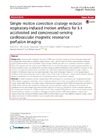Simple motion correction strategy reduces respiratory-induced motion artifacts for k-t accelerated and compressed-sensing cardiovascular magnetic resonance perfusion imaging
dc.contributor.author
Zhou, Ruixi
dc.contributor.author
Huang, Wei
dc.contributor.author
Yang, Yang
dc.contributor.author
Chen, Xiao
dc.contributor.author
Weller, Daniel S.
dc.contributor.author
Kramer, Christopher M.
dc.contributor.author
Kozerke, Sebastian
dc.contributor.author
Salerno, Michael
dc.date.accessioned
2020-04-24T08:19:51Z
dc.date.available
2018-02-10T03:03:46Z
dc.date.available
2018-02-19T14:17:33Z
dc.date.available
2020-04-24T08:19:51Z
dc.date.issued
2018-02-01
dc.identifier.issn
1097-6647
dc.identifier.issn
1532-429X
dc.identifier.other
10.1186/s12968-018-0427-1
en_US
dc.identifier.uri
http://hdl.handle.net/20.500.11850/239863
dc.identifier.doi
10.3929/ethz-b-000239863
dc.description.abstract
Background
Cardiovascular magnetic resonance (CMR) stress perfusion imaging provides important diagnostic and prognostic information in coronary artery disease (CAD). Current clinical sequences have limited temporal and/or spatial resolution, and incomplete heart coverage. Techniques such as k-t principal component analysis (PCA) or k-t sparcity and low rank structure (SLR), which rely on the high degree of spatiotemporal correlation in first-pass perfusion data, can significantly accelerate image acquisition mitigating these problems. However, in the presence of respiratory motion, these techniques can suffer from significant degradation of image quality. A number of techniques based on non-rigid registration have been developed. However, to first approximation, breathing motion predominantly results in rigid motion of the heart. To this end, a simple robust motion correction strategy is proposed for k-t accelerated and compressed sensing (CS) perfusion imaging.
Methods
A simple respiratory motion compensation (MC) strategy for k-t accelerated and compressed-sensing CMR perfusion imaging to selectively correct respiratory motion of the heart was implemented based on linear k-space phase shifts derived from rigid motion registration of a region-of-interest (ROI) encompassing the heart. A variable density Poisson disk acquisition strategy was used to minimize coherent aliasing in the presence of respiratory motion, and images were reconstructed using k-t PCA and k-t SLR with or without motion correction. The strategy was evaluated in a CMR-extended cardiac torso digital (XCAT) phantom and in prospectively acquired first-pass perfusion studies in 12 subjects undergoing clinically ordered CMR studies. Phantom studies were assessed using the Structural Similarity Index (SSIM) and Root Mean Square Error (RMSE). In patient studies, image quality was scored in a blinded fashion by two experienced cardiologists.
Results
In the phantom experiments, images reconstructed with the MC strategy had higher SSIM (p < 0.01) and lower RMSE (p < 0.01) in the presence of respiratory motion. For patient studies, the MC strategy improved k-t PCA and k-t SLR reconstruction image quality (p < 0.01). The performance of k-t SLR without motion correction demonstrated improved image quality as compared to k-t PCA in the setting of respiratory motion (p < 0.01), while with motion correction there is a trend of better performance in k-t SLR as compared with motion corrected k-t PCA.
Conclusions
Our simple and robust rigid motion compensation strategy greatly reduces motion artifacts and improves image quality for standard k-t PCA and k-t SLR techniques in setting of respiratory motion due to imperfect breath-holding.
en_US
dc.format
application/pdf
en_US
dc.language.iso
en
en_US
dc.publisher
BioMed Central
dc.rights.uri
http://creativecommons.org/licenses/by/4.0/
dc.subject
CMR perfusion
en_US
dc.subject
Motion compensation
en_US
dc.subject
K-t acceleration
en_US
dc.subject
Image reconstruction
en_US
dc.subject
Myocardial perfusion
en_US
dc.title
Simple motion correction strategy reduces respiratory-induced motion artifacts for k-t accelerated and compressed-sensing cardiovascular magnetic resonance perfusion imaging
en_US
dc.type
Journal Article
dc.rights.license
Creative Commons Attribution 4.0 International
ethz.journal.title
Journal of Cardiovascular Magnetic Resonance
ethz.journal.volume
20
en_US
ethz.journal.issue
1
en_US
ethz.journal.abbreviated
J Cardiovasc Magn Reson
ethz.pages.start
6
en_US
ethz.size
13 p.
en_US
ethz.version.deposit
publishedVersion
en_US
ethz.identifier.wos
ethz.identifier.scopus
ethz.publication.place
London
en_US
ethz.publication.status
published
en_US
ethz.leitzahl
ETH Zürich::00002 - ETH Zürich::00012 - Lehre und Forschung::00007 - Departemente::02140 - Dep. Inf.technologie und Elektrotechnik / Dep. of Inform.Technol. Electrical Eng.::02631 - Institut für Biomedizinische Technik / Institute for Biomedical Engineering::09548 - Kozerke, Sebastian / Kozerke, Sebastian
en_US
ethz.leitzahl
ETH Zürich::00002 - ETH Zürich::00012 - Lehre und Forschung::00007 - Departemente::02140 - Dep. Inf.technologie und Elektrotechnik / Dep. of Inform.Technol. Electrical Eng.::02631 - Institut für Biomedizinische Technik / Institute for Biomedical Engineering::09548 - Kozerke, Sebastian / Kozerke, Sebastian
en_US
ethz.leitzahl.certified
ETH Zürich::00002 - ETH Zürich::00012 - Lehre und Forschung::00007 - Departemente::02140 - Dep. Inf.technologie und Elektrotechnik / Dep. of Inform.Technol. Electrical Eng.::02631 - Institut für Biomedizinische Technik / Institute for Biomedical Engineering::09548 - Kozerke, Sebastian / Kozerke, Sebastian
ethz.leitzahl.certified
ETH Zürich::00002 - ETH Zürich::00012 - Lehre und Forschung::00007 - Departemente::02140 - Dep. Inf.technologie und Elektrotechnik / Dep. of Inform.Technol. Electrical Eng.::02631 - Institut für Biomedizinische Technik / Institute for Biomedical Engineering::09548 - Kozerke, Sebastian / Kozerke, Sebastian
ethz.relation.isReferencedBy
10.3929/ethz-b-000256948
ethz.date.deposited
2018-02-10T03:04:17Z
ethz.source
WOS
ethz.eth
yes
en_US
ethz.availability
Open access
en_US
ethz.rosetta.installDate
2018-02-19T14:17:40Z
ethz.rosetta.lastUpdated
2024-02-02T10:48:17Z
ethz.rosetta.versionExported
true
ethz.COinS
ctx_ver=Z39.88-2004&rft_val_fmt=info:ofi/fmt:kev:mtx:journal&rft.atitle=Simple%20motion%20correction%20strategy%20reduces%20respiratory-induced%20motion%20artifacts%20for%20k-t%20accelerated%20and%20compressed-sensing%20cardiovascular%20magn&rft.jtitle=Journal%20of%20Cardiovascular%20Magnetic%20Resonance&rft.date=2018-02-01&rft.volume=20&rft.issue=1&rft.spage=6&rft.issn=1097-6647&1532-429X&rft.au=Zhou,%20Ruixi&Huang,%20Wei&Yang,%20Yang&Chen,%20Xiao&Weller,%20Daniel%20S.&rft.genre=article&rft_id=info:doi/10.1186/s12968-018-0427-1&
Files in this item
Publication type
-
Journal Article [128832]

